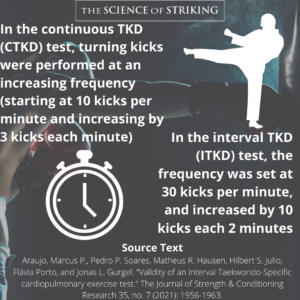There has been a rapid increase in the number of combat sports-specific fitness tests being assessed in research environments and utilised in the field. This should in theory lead to more accurate assessment of sports-specific performance and optimised program design.
The researchers in this study sought to investigate the validity of a taekwondo (TKD)-specific cardiopulmonary test, and compare it to a traditional cardiopulmonary exercise test (CPET) and a continuous TKD-specific exercise test.
15 competitive male TKD athletes performed 3 different protocols on separate days, separated by 2-7 days. A portable gas analyser was used to measure VO2 and heart rate measurements were also recorded.
- The CPET consisted of a typical running ramp protocol.
- In the continuous TKD (CTKD) test, turning kicks were performed at an increasing frequency (starting at 10 kicks per minute and increasing by 3 kicks each minute), and at a threshold kicking power (established pre-test as a typical competition scoring impact).
- In the interval TKD (ITKD) test, the frequency was set at 30 kicks per minute, and increased by 10 kicks each 2 minutes. Each 2-minute bout was separated by a 1 minute interval
All of the tests were ceased upon 3 out of 4 criteria achieved of:
- BORG RPE score of 10/10
- >90% of age-predicted Max HR or plateau in HR
- Plateau in change of VO2
- Gas exchange score >1.1
High peak VO2 values as well as VO2 at ventilatory threshold 1 were seen in the 2 continuous tests. Reliability measures were similar between the 3 tests.
Considering the difference in values between the different types of tests, there may be utility in incorporating both continuous and intermittent testing protocols in the cardiovascular assessment of TKD athletes.
#taekwondo #tkd #olympictaekwondo #tokyo2020 #thescienceofstriking #karate #kicking #sportsperformance #cardiovascular #assessment #monitoring #training




